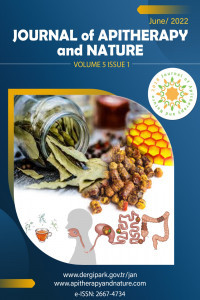Chemical Profiling of Papua New Guinea Propolis and Assay its Antiprotozoal Activity
Chemical Profiling of Papua New Guinea Propolis and Assay its Antiprotozoal Activity
___
- .
- Yayın Aralığı: Yılda 2 Sayı
- Başlangıç: 2018
- Yayıncı: Oktay YILDIZ
Soumaya TOUZANI, Sleman KADAN, Abdalsalam KMAIL, Bashar SAAD, Badiaa LYOUSSI
Isolated Xanthones from Lisotrigona furva Propolis in Vietnam
Le Nguyen THANH, Ha Thi THOA, Vu Thi Kim OANH, Diep Thi Lan PHUONG, Hoang Thi VAN, Nguyen Quynh CHI, Tran Huu GIAP, Nguyen Thi Tu OANH, Nguyen Thi Minh HANG, Nguyen Van HUNG, Chau Van MINH, Vassya BANKOVA
Effects of Propolis on the Quorum Sensing of Selected Biofilm Producing Bacterial Species
K. TENNICK, S. WAFA, H. FEARNLEY, M. GOMEZ ESCALADA
Water Extract of Propolis Might be Safer to Use During Pregnancy than Ethanol Extract
Al Mukhlas FIKRI, Ahmad SULAEMAN, Sri Anna MARLIYATI, Mokhamad FAHRUDIN
Chemical Profile and Botanical Origin of Stingless Bee Propolis from Thailand and Indonesia
Portuguese Propolis: A Potenial Source of Environmentally Friendly Fungicides
Catarina PASSÃO, Claudia RODRIGUES, Cristina Almeida AGUIAR, Ana CUNHA
Shankar KATEKHAYE, Hugo FEARNLEY, James FEARNLEY, Anant PARADKAR
Fatty Acid Analysis and Biological Activity of Jordanian Propolis
Ashok K. SHAKYA, Shankar KATEKHAYE, Ghaleb A. ORIQUAT, Rajashri R. NAIK, Rajashri R. NAIK, Anant PARADKAR, Hugo FEARNLEY, James FEARNLEY
Propolis: A Natural Product – Great Potential as a Medicine
“Green” Synthesis of Gold and Silver Nanoparticles with Propolis Extract and Rosa damascena Waste
Anton M. SLAVOV, Daniela KARASHANOVA, Biliana GEORGIEVA, İvelina VASILEVA, Vassya BANKOVA, Rada DINKOVA, Nikoleta YANTCHEVA
